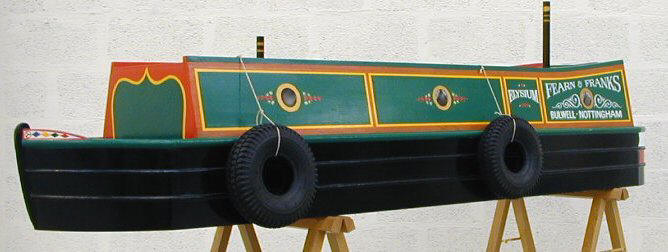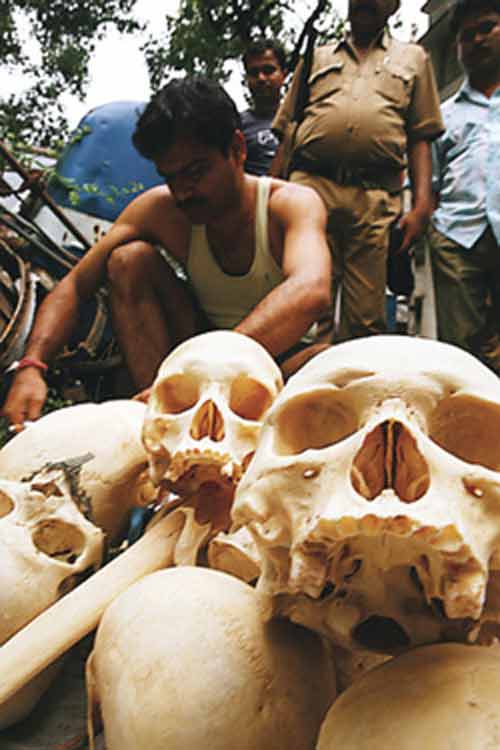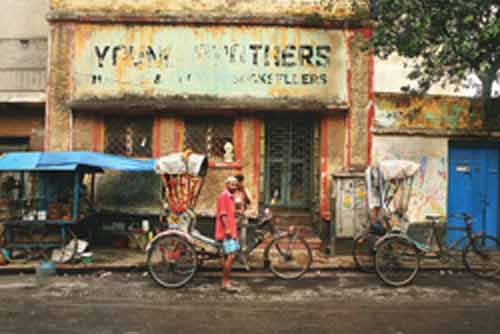When It's Time to Move On
Exhibiting a Sense of the AbsurdOf all escape mechanisms, death is the most efficient. - Henry Ward Beecher
Steeling herself for the trip Madcap, zany or just plain weird, there’s no doubt the opening exhibition of 2003 at the Cork Vision Centre is an exhibition with a difference that will attract a lot of attention. Entitled Crazy Coffins, it is exactly as described – a collection of bizarre and crazy caskets, each one designed by its living owner as a celebration of life lived to the full.
Each of the exhibited coffins is a work of art in its own right. All are owner-designed and are made up of a variety of weird wonderful shapes and sizes. From the large box kite complete with suspended coffin to the skateboard shaped coffin this exhibition will appeal to those who appreciate the zany and the absurd. Indeed, if one feels up to it one may follow the example of the owners of a canal boat coffin who currently use it as a drinks table (photo below). In recognition of Cork’s Capital of Culture status, two specifically Cork-theme coffins have been custom-designed. Made of cork, and cylindrical in shape one resembles a wine cork complete with corkscrew while the other entitled “Conrai na Chorcaigh” has been designed to appear as if it is emerging from a marsh as a homage to Cork city’s origins.
Sorry for barging in like this... Source: corkvisioncentre.com
The Dutch Way of DeathSocialised Medicine Has Helped Turn Doctors into Killersby Richard Miniter Amsterdam - Seven years ago, Dr Niko Wolswinkel was asked to kill someone. On a Monday morning that he will never forget, the Dutch physician's patient, a 77-year old woman dying from cancer, asked him to kill her. As a purely legal matter, he knew he could do it. While euthanasia had not yet been officially decriminalised in the Netherlands - that happened earlier this month - in practice, it had. A string of high-profile court rulings in the 1980s made it nearly impossible for prosecutors to win euthanasia cases, and in the few instances in which doctors were convicted, their sentences were suspended. The Royal Dutch Medical Association had publicly approved of euthanasia, which was common even then. All that stood between euthanasia and his patient, Dr Wolswinkel knew, was his own willingness to comply. On that day, he searched his conscience. "It is very hard to speak of these things," Dr Wolswinkel said, with a quiet sadness in his voice. "Thirty years ago, this was something that people didn't ask for." He couldn't bring himself to kill his patient; doctors are supposed to be healers, not killers. And, as a Christian, he believed it was wrong to take into his hands the power of God. A few days later, his patient died naturally. Most Dutchmen have come to a different conclusion; more than 80% favor "voluntary euthanasia," according to recent polls. The Dutch Parliament recently passed a measure completely decriminalising euthanasia and doctor-assisted suicide. The Netherlands is now the first democratic nation on earth to permit, under law, doctors to kill their patients. And they may be accustomed to doing so. Of the 130,000 Dutchmen who died in 1990, some 11,800 were killed or helped to die by their doctors, according to a 1991 report by the attorney general of the High Council of the Netherlands. (The 1991 report is the only complete report on euthanasia practices by the Dutch government.) Some of these deaths are the classic cases cited by right-to-die advocates: A terminally ill patient, in agony, demanding to "die with dignity." But many are not. An estimated 5,981 people - an average of 16 per day - were killed by their doctors without their consent, according to the Dutch government report. And these numbers do not measure several other groups that are put to death involuntarily: disabled infants, terminally ill children and mental patients. Some 8% of all infants who die in the Netherlands are killed by their doctors, according to a 1997 study published in the Lancet, a British medical journal. Consider the case of Dr Henk Prins, who killed - with her parents' consent - a 3-day old girl with spina bifida and an open wound at the base of her spine. Dr Prins never made any attempt to treat the wound, according to Wesley J Smith, author of the book Culture of Death. The treatment was death. Euthanasia critics have talked about the "slippery slope" as a possibility; in the Netherlands, it is a fact. Many old people now fear Dutch hospitals. More than 10% of senior citizens who responded to a recent survey, which did not mention euthanasia, volunteered that they feared being killed by their doctors without their consent. One senior-citizen group printed up wallet cards that tell doctors that the cardholder opposes euthanasia. What makes the Dutch comfortable with euthanasia? One factor is that their doctors became comfortable with it. "The Dutch have got so far so fast because right from the beginning, they have had the medical profession on their side," Derek Humphrey, founder of the Hemlock Society, told the Toronto Globe and Mail last September. "Until we get a significant part of the medical profession on our side, we won't get very far." Some suggest that Dutch doctors are naturally more inclined toward euthanasia. That seems unlikely. In contrast to the physicians of every other Nazi-occupied country, Dutch doctors never recommended or participated in a single euthanasia during World War II, according to a 1949 New England Journal of Medicine article. Even Nazi orders not to treat the old or those with little chance of recovery were disobeyed. It only took a generation, essayist Malcolm Muggeridge noted, "to transform a war crime into an act of compassion." How did Dutch doctors change their thinking so dramatically in the space of one lifetime? The path to the death culture began when doctors learned to think like accountants. As the cost of socialised medicine in the Netherlands grew, doctors were lectured about the importance of keeping expenses down. In many hospitals, signs were posted indicating how much old-age treatments cost taxpayers. The result was a growing "social pressure" from doctors and others, says Arno Heltzel, a spokesman for the Catholic Union of the Elderly, the largest Dutch senior-citizen group, which favors voluntary euthanasia. "Old people have to excuse themselves for living. When they say that all of their friends are dead, people say, 'Maybe it is time for you to go too,' rather than, 'You need to find new friends.'" With such pressure, even the "voluntary" euthanasia cases may not be truly consensual. Add to that the remarkable 33% drop in elderly suicides with an almost equal rise in euthanasia in the same age group over the past two decades. What Dr Herbert Hendin, a euthanasia opponent, calls "the Dutch cure for suicide" may simply be evidence of untreated depression. But treatment is costly. Professional restrictions against euthanasia were cast aside. The Hippocratic Oath, a 2,500-year old credo meant to curb ancient temptations, includes the pledge: "I will not give a fatal draught to anyone if I am asked, nor will I suggest any such thing." Few medical schools in any developed nation require the oath. Other professional codes have been rewritten to be neutral or supportive of euthanasia. Medical school curricula and professional standards were changed, too. Nearly every major medical school offers a bioethics class in which euthanasia is considered, at least, an open question. Euthanasia is now an option, not a taboo. The Dutch Pediatric Society issued guidelines for killing infants in 1993; the Royal Dutch Society of Pharmacology sends a book to all new doctors that includes formulas for euthanasia-inducing poisons. Then came the bogus ethicists. Many of these "medical ethics experts" are drawn from or influenced by the global pro-death subculture - the World Federation of Right-to-Die Societies lists 36 groups in 21 countries - that stretches from Australia's Dr Philip Nitschke ("Dr Death") to Princeton University's Peter Singer. Many of them are doctors. "They can be very charming," said Rita L Marker, executive director of the International Anti-Euthanasia Task Force. They can also be very influential; they seemed to have shaped the thinking of the Dutch health minister, Els Borst. Ms Borst, who is 69, recently called for a suicide pill for healthy but "bored" old people. Over time, euthanasia came to be seen as normal. When I phoned Amsterdam's Academic Medical Centre, a spokeswoman told me that she approved of involuntary euthanasia for disabled infants: "It is the same in all the hospitals in the world; we are just more open about it." Most hospitals try heroically to save disabled children, but the contrary view seems to be widely held among the Dutch. Finally, the feckless politicians enter the frame. There is no major party unequivocally opposed to euthanasia in principle, not even the right-of-center Christian Democrats, who have shared power for most of the postwar period. "There is no broad opposition to euthanasia, even in Christian circles," laments Kars Veling, a member of Parliament who will lead the Christian Union party next year. After speaking to a packed party meeting in Spakenburg, Mr Veling soberly talks about watching his father die. The old man was suffering terribly. "We prayed for the Lord to take him," he said. The doctor offered a lethal injection. It was hard to say no, he said, but his father had never asked for death and such an end would have been contrary to the values by which he lived. Dutch doctors are free to make such fatal offers. Every legal and professional barrier to euthanasia has been demolished, often by doctors themselves. Euthanasia began with doctors, and only an awakening of their conscience can stop it now. Mr Miniter is an editorial page writer at The Wall Street Journal Europe. Source: opinionjournal.com 28 April 2001
Inside India's Underground Trade in Human Remains
A police officer in Burdwan, West Bengal, displays a cache of skulls confiscated from by Scott Carney A constable in a sweat-stained undershirt and checkered blue sarong lays a ragged cloth over a patch of mud. He jerks open the back door of a decrepit Indian-made Tata Sumo SUV - what passes for an evidence locker at this rustic police outpost in the Indian state of West Bengal. A hundred human skulls tumble out onto the cloth, making a hollow clatter as they fall to the ground. They've lost most of their teeth bouncing around the back of the truck. Bits of bone and enamel scatter like snowflakes around the growing pile. Standing next to the truck, the ranking officer smiles and lets out a satisfied grunt. "Now you can see how big the bone business is here," he says. I crouch down and pick up a skull. It's lighter than I expected. I hold it up to my nose. It smells like fried chicken. Before the authorities intercepted it, this cache was moving along a well-established pipeline for human skeletal remains. For 150 years, India's bone trade has followed a route from remote Indian villages to the world's most distinguished medical schools. Skeletons aren't easy to get. In the US, for instance, most corpses receive a prompt burial, and bodies donated to science usually end up on the dissection table, their bones sawed to pieces and destined for cremation. So most skeletons used for medical study come from overseas. Often they arrive without the informed consent of their former owners and in violation of the laws of their country of origin. India has long been the world's primary source of bones used in medical study, renowned for producing specimens scrubbed to a pristine white patina and fitted with high-quality connecting hardware. In 1985, however, the Indian government outlawed the export of human remains, and the global supply of skeletons collapsed. Western countries turned to China and Eastern Europe, but those regions produce relatively few skeletons. They have little experience producing display-quality specimens, and their products are regarded as inferior. Now, 22 years after India's export ban, there are signs that the trade never ended. Black-market vendors in West Bengal continue to supply human skeletons and skulls using the time-honoured method: Rob graves, separate soft flesh from unyielding calcium, and deliver the bones to distributors - who assemble them and ship them to dealers around the globe. Exports to North America are still small compared with pre-ban levels, but shipments are finding their way to American medical programmes. Suppliers have ample incentive - it's a lucrative business. The skulls on the ground before me, for instance, would fetch an estimated $70,000 overseas. The constable grabs the cloth by its corners and gathers the evidence into a bundle. "You know, I've never seen anything like this," he says. "I hope I don't again." A massive low-pressure system over the Bay of Bengal is threatening to flood the state of West Bengal. Newspapers have already dubbed the storm a "watery apocalypse" after 8 people drowned in floods before it even touched land. I'm driving to the tiny village of Purbasthali - about 80 miles outside of Kolkata, the state capital - the site of the processing plant where the police discovered their load of skulls. My rented Toyota Qualis gets stuck in the mud half a mile from the facility, so I jump out to make my way on foot. The sky is pitch-black, the rain suffocating. Toads the size of boxing gloves hop across the muddy track. When police arrived to investigate last spring, they could smell the stench of rotting flesh from nearly a mile away. Sections of spine strung together with twine dangled from the rafters, an officer told me. Hundreds of bones were scattered on the floor in some sort of ordering system. This bone factory had been operating for more than 100 years when two of its workers, drinking at a bar, bragged that they were hired to dig bodies out of graves. Shocked villagers dragged them to a police station, where they confessed. The workers said a man named Mukti Biswas ran the factory. The authorities knew him well. In 2006, police had arrested Biswas as the kingpin of a grave-robbing ring; he was released a day later, news reports said, "because of his political links." The police took him into custody once again, but he was let out on bail and has since taken flight. After 10 minutes of slogging through the mud, I make out the flicker of a gas lamp. I peek into the doorway of a wood-frame house. A family of four sitting on the dirt floor stares back at me. "Do you know Mukti Biswas?" I ask. "The bastard still owes me money," replies Manoj Pal, a twenty-something man with a thin mustache. His family has been working at the bone factory for generations, he says. He offers to show me around, and we head out along the bank of the Bhagirathi River. The processing plant is little more than a bamboo hut with a tarpaulin roof - one of a dozen bone factories Pal says he knows about. In April, the authorities confiscated piles of bones, buckets of hydrochloric acid, and two barrels full of a caustic chemical they have yet to identify. All that's left is a dirt floor with a large concrete vat sunk into the ground. A third-generation bone trader, Biswas had no problem finding dead bodies. As caretaker of the village's cremation ground, he claimed to have a license to dispose of the dead. But police told reporters he was robbing graves. Biswas pilfered corpses from cemeteries, morgues, and funeral pyres; he would drag the deceased from the flames as soon as the families left. He employed almost a dozen people to shepherd the bones through the various stages of de-fleshing and curing. For this work, Pal says he earned $1.25 a day. He also received a bonus for keeping the bones from a given body together so they represented a biological individual rather than a mishmash of parts - a feature prized by doctors. Pal explains the factory's production process. First the corpses were wrapped in netting and anchored in the river, where bacteria and fish reduced a body to a loose pile of bones and mush in a week or so. The crew then scrubbed the bones and boiled them in a cauldron of water and caustic soda to dissolve any remaining flesh. That left the calcium surfaces with a yellow tint. To bring them up to medical white, bones were then left in sunlight for a week before being soaked in hydrochloric acid. Biswas sold complete skeletons wholesale for $45 to a medical supply company called Young Brothers, which wired the pieces together, painted on medical diagrams, and sawed away sections of the skulls to reveal internal structures. Then Young Brothers sold the bones to dealers around the world.
photo: Rennio Maifredi Shining my flashlight on the floor, I pick up a wet rag. The translator lets out a low hiss. "I hope you know that's a death shroud," he says. I drop the cloth and wipe my hand on my shirt. The empirical study of human anatomy took off with Leonardo da Vinci's sketches in the 15th century; the earliest extant articulated skeleton dates from 1543. As medicine advanced, physicians were expected to have a systematic understanding of the human body's inner workings. By the beginning of the 19th century, Europe's demand for human remains far outstripped supply. In England, home of many of the world's preeminent medical institutions, grave robbing became so commonplace that certain cemeteries were famous for battles between grieving families and marauding medical students. To contain the problem, the government passed the Anatomy Act of 1832, allowing doctors to take any corpse that was left unclaimed in a city morgue or hospital. The law put an end to grave robbery, but the supply of legal skeletons still couldn't keep up with demand. So British doctors looked to the colonies. In India, members of the dom caste, who traditionally performed cremations, were pressed into service processing bones. In the 1850s, Calcutta Medical College processed 900 skeletons a year, mostly for shipment abroad. A century later, a newly independent India dominated the world market for human bones. In 1985, the Chicago Tribune reported that India had exported about 60,000 skulls and skeletons the year before. The supply was sufficient for every medical student in the developed world to buy a bone box along with their textbooks. Price: $300. If most of the merchandise was stolen, at least exporting it was legal. "For years, we ran everything aboveboard," Bimalendu Bhattacharjee, a former president of the Indian Association of Exporters of Anatomical Specimens, told the Los Angeles Times in 1991. "No one advertised, but everyone knew it was going on." At their height, Kolkata's bone factories took in an estimated $1 million a year. But it couldn't last. The graveyards of West Bengal were being picked clean, and the lure of ready money soon attracted criminal elements. The industry shuddered to a halt in March 1985, when a bone trader was arrested after exporting 1,500 child skeletons. Because they're relatively rare and illustrate transitional stages in osteological development, child skeletons command higher prices. Indian newspapers claimed that children were being kidnapped and killed for their bones. Panic spread with news of the arrest. In the months after the indictment, vigilantes combed the cities searching for members of the alleged kidnappers' network. In September, an Australian tourist was killed and a Japanese tourist was beaten by a mob after rumours spread that they were involved in the conspiracy. The attacks might have been enough to stall India's bone industry, but the government had already taken action: A few weeks earlier, India's Supreme Court interpreted the national Import/Export Control Act to prohibit the export of human tissue. In the absence of competing suppliers in other countries, the court's decision effectively shut down international trade in human skeletons. Medical schools in the US and Europe begged the Indian government to reverse the export ban, to no avail. Since then, natural human bone has been difficult to come by. The voracious demand for fresh cadavers in medical education consumes nearly all donated corpses in the US, and in any case, processing skeletons is a slow, messy business that few people care to take on. When high-quality specimens do become available, they tend to be costly. A complete skeleton in good condition now retails for several thousand dollars, and orders can take months, even years, to fulfill. Students no longer buy their own bone boxes; instead, schools usually keep an inventory that's replaced only when specimens are damaged or stolen. Stanford Medical School allocates half a skeleton, cleaved down the middle, for every two students. Such policies mean that many established institutions already have all the bones they need. The biggest buyers of skeletons are new and growing schools throughout the world that need to outfit their labs. Some institutions have turned to plastic replicas. But artificial substitutes aren't ideal. "Plastic models are reproductions of a single specimen and don't include the range of variations found in real osteology," says Samuel Kennedy, who stocks the anatomy program at Harvard Medical School. Students trained on facsimiles never see these differences among individuals. Moreover, the models aren't entirely accurate. "The moulding process doesn't capture the detail of a real specimen," Kennedy adds. "This is especially critical in the skull." In the US, major dealers like Kilgore International are making do selling replicas. "My father would have done almost anything to get back into the bone business," says Craig Kilgore, who runs the company his father founded. "He was legally blind but would still come to the office and write letters to anyone, anywhere in the world, that he felt could be of help to reopen the supply." His father, who died in 1995, didn't live to see the turnaround.
The gated entrance to Young Brothers in Kolkata. Tucked away on a side street between one of Kolkata's largest graveyards and one of its busiest hospitals, Young Brothers' headquarters looks more like an abandoned warehouse than a leading distributor of human skeletons. The rusted front gate appears to have been padlocked and forgotten a decade ago. Above the entrance, the company sign is a tableau of peeling paint. It wasn't always this way. The building was bustling with activity in 2001, according to former Kolkata Health Department chief Javed Ahmed Khan. At the time, neighbours complained that the Young Brothers offices stank of death. Huge piles of bones lay drying on the roof. When the police refused to file a case, Khan raided the building with a posse of bamboo-wielding heavies. "There were two rooms full of human skeletons," Khan recalls. It took 5 trucks to haul them away. He also seized thousands of documents, including invoices to companies all around the world. "They were sending shipments to Thailand, Brazil, Europe, and the United States," he says. Sixteen years after the export ban, it was as if the law had never taken effect. "We used to fill orders all over the world," says a clerk employed by Young Brothers between 1999 and 2001, who requested anonymity. "We used to buy bones from Mukti Biswas. I saw more than 5,000 dead bodies." There were other suppliers, too, and factories up and down the length of West Bengal. The company took in roughly $15,000 a month. Khan's raid prompted the police to arrest Young Brothers' owner, Vinesh Aron. He spent two nights in jail before being released. Today, there are no bones on the roof. I've been poking around the area for an hour or so, interviewing neighbours, when a white van pulls up to the building. A man dressed in a pink-checkered shirt steps out. He walks briskly to a side door and knocks: Vinesh Aron. Aron sees me snapping photos and knocks more forcefully, but the assistant inside is having trouble with the lock. As I try to formulate a question, my translator shoves a microphone in his face and asks whether he's still shipping skeletons to the West. Looking flustered, Aron blurts, "We won that case!" The entrance cracks open and he slips in before the door slams in my face. In a subsequent phone conversation, Aron says he now sells medical models and charts, but no bones. However, a vendor of surgical instrument supplies who claims to be his brother-in-law says Young Brothers is the only bone distributor in the country. "My brother-in-law is the only man who still does this in India. He is the only one with guts," he says. Then he offers to dig up a skeleton for me for 1,000 rupees ($25). The most recent Young Brothers catalog (2006 - 2007) takes care to inform customers that it abides by the law. It lists a wide assortment of bones at wholesale prices, noting that they're "for sale in India only." Indian skeletons are somehow making it out of the country anyway. In Canada, Osta International sells human bones throughout the US and Europe. The 40-year-old company offers to fill orders immediately. "About half of our business is in the States," says Christian Ruediger, who runs the business with his father, Hans. Ruediger admits that Osta stocks bones from India, presumably smuggled out of the country in violation of the export law. Until a few years ago, he got them from a distributor in Paris, but that source dried up in 2001 - around the time Javed Khan raided Young Brothers. Since then, he has bought his stock from a middleman in Singapore. He declines to provide the name. "We want to keep a low profile," he says. Of some 30 institutions I contacted in the course of researching this article, the handful that admitted to buying bones in the past few years declined to reveal their sources or speak on record. Osta's name came up twice. "I bought a complete skeleton and a dissected human demonstration skull from Osta," a professor at a prestigious Virginia college says. "Both were excellent." Another Osta customer is a firm called Dentsply Rinn, which offers a plastic model head containing a real skull, used in training dentists. "It's very difficult to procure human bones," marketing manager Kimberly Brown says. "Our requirements stipulate that the skulls must be of a certain size and grade and without certain anatomical defects. But we have no requirement for their origin." Indian authorities express a similar lack of concern. Although the international bone trade violates the national export law and local statutes against grave desecration, officials look the other way. "This is not a new thing," says Rajeev Kumar, West Bengal's deputy inspector general of police. "There's no evidence that they were killing people." The police took an interest in Biswas only because the bodies of a few important people went missing. "We are trying to implement the law based on the stress society places on it," he adds. "Society does not see this as a very serious thing." The need to study human bones in medicine is well established. The need to obtain the informed consent of people whose bones are studied is not. The reemergence of India's bone trade reflects the tension between these requirements. Someday doctors may develop a supply chain based on voluntary donation. Meanwhile, the bone factories of Kolkata are open for business. Scott Carney (scottcarneyonline.com) wrote about auto-rickshaw racing in issue 15.01. Source: wired.com 27 November 2007
See also:
For articles related to ageing, including feats that can be accomplished, and a non-spiritual look at what happens after death - funerals, jerky, popsicles, fertiliser, ashes, orbit or dust - click the
"Up" button below to take you to the Index page for this Older and Under section. |
 Animals
Animals Animation
Animation Art of Playing Cards
Art of Playing Cards Drugs
Drugs Education
Education Environment
Environment Flying
Flying History
History Humour
Humour Immigration
Immigration Info/Tech
Info/Tech Intellectual/Entertaining
Intellectual/Entertaining Lifestyles
Lifestyles Men
Men Money/Politics/Law
Money/Politics/Law New Jersey
New Jersey Odds and Oddities
Odds and Oddities Older & Under
Older & Under Photography
Photography Prisons
Prisons Relationships
Relationships Science
Science Social/Cultural
Social/Cultural Terrorism
Terrorism Wellington
Wellington Working
Working Zero Return Investment
Zero Return Investment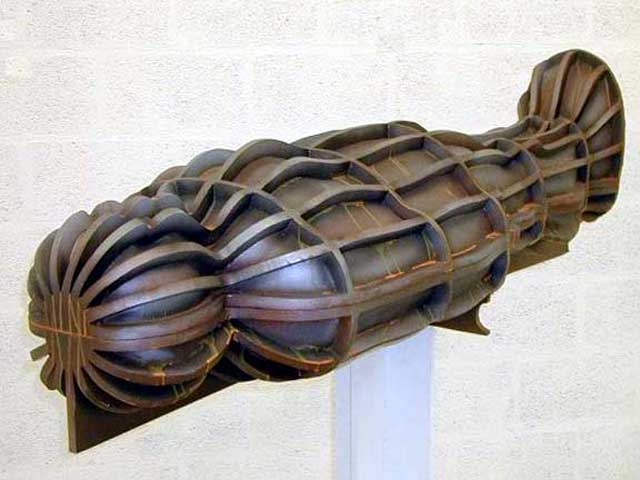
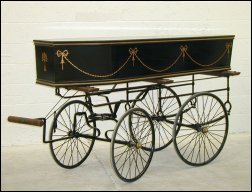 Made by UK based expert designers and coffin-makers, Vic Fearn & Co Limited who have been in the business since 1860,
the coffins included in the Crazy Coffin Exhibition reflect the development of a creative side to the business over the past decade or so. During this period, they were approached by an ever-increasing
number of people who wanted to choose caskets designed to meet their own unique needs. Out of this grew the Crazy Coffin collection which has been exhibited widely throughout Britain.
Made by UK based expert designers and coffin-makers, Vic Fearn & Co Limited who have been in the business since 1860,
the coffins included in the Crazy Coffin Exhibition reflect the development of a creative side to the business over the past decade or so. During this period, they were approached by an ever-increasing
number of people who wanted to choose caskets designed to meet their own unique needs. Out of this grew the Crazy Coffin collection which has been exhibited widely throughout Britain. According to Cork Vision Centre Director, John X Miller, this is the first time it has exhibited
outside the UK, and the Cork Vision Centre is the only Irish venue it will exhibit in. “Definitely an exhibition with a difference, it’s an eye-catching aesthetically-pleasing artistic celebration of
life with all its quirks, foibles and eccentricities.”
According to Cork Vision Centre Director, John X Miller, this is the first time it has exhibited
outside the UK, and the Cork Vision Centre is the only Irish venue it will exhibit in. “Definitely an exhibition with a difference, it’s an eye-catching aesthetically-pleasing artistic celebration of
life with all its quirks, foibles and eccentricities.”